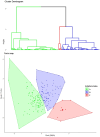The combination of kidney function variables with cell cycle arrest biomarkers identifies distinct subphenotypes of sepsis-associated acute kidney injury: a post-hoc analysis (the PHENAKI study)
- PMID: 38445412
- PMCID: PMC10919311
- DOI: 10.1080/0886022X.2024.2325640
The combination of kidney function variables with cell cycle arrest biomarkers identifies distinct subphenotypes of sepsis-associated acute kidney injury: a post-hoc analysis (the PHENAKI study)
Abstract
Background: The severity and course of sepsis-associated acute kidney injury (SA-AKI) are correlated with the mortality rate. Early detection of SA-AKI subphenotypes might facilitate the rapid provision of individualized care.
Patients and methods: In this post-hoc analysis of a multicenter prospective study, we combined conventional kidney function variables with serial measurements of urine (tissue inhibitor of metalloproteinase-2 [TIMP-2])* (insulin-like growth factor-binding protein [IGFBP7]) at 0, 6, 12, and 24 h) and then using an unsupervised hierarchical clustering of principal components (HCPC) approach to identify different phenotypes of SA-AKI. We then compared the subphenotypes with regard to a composite outcome of in-hospital death or the initiation of renal replacement therapy (RRT).
Results: We included 184 patients presenting SA-AKI within 6 h of the initiation of catecholamines. Three distinct subphenotypes were identified: subphenotype A (99 patients) was characterized by a normal urine output (UO), a low SCr and a low [TIMP-2]*[IGFBP7] level; subphenotype B (74 patients) was characterized by existing chronic kidney disease (CKD), a higher SCr, a low UO, and an intermediate [TIMP-2]*[IGFBP7] level; and subphenotype C was characterized by very low UO, a very high [TIMP-2]*[IGFBP7] level, and an intermediate SCr level. With subphenotype A as the reference, the adjusted hazard ratio (aHR) [95%CI] for the composite outcome was 3.77 [1.92-7.42] (p < 0.001) for subphenotype B and 4.80 [1.67-13.82] (p = 0.004) for subphenotype C.
Conclusions: Combining conventional kidney function variables with urine measurements of [TIMP-2]*[IGFBP7] might help to identify distinct SA-AKI subphenotypes with different short-term courses and survival rates.
Keywords: Acute kidney injury; The AKI-CHECK study was registered at ClinicalTrials.gov (NCT02812784); biomarkers; cluster; phenotype; septic shock.
Conflict of interest statement
The authors declare that they have no competing interests.
Figures





Similar articles
-
Predictive performance of two types of urinary biomarkers for renal non-recovery in sepsis-associated acute kidney injury: a prospective observational study.BMC Nephrol. 2024 May 3;25(1):153. doi: 10.1186/s12882-024-03589-9. BMC Nephrol. 2024. PMID: 38702662 Free PMC article.
-
Urine cell cycle arrest biomarkers distinguish poorly between transient and persistent AKI in early septic shock: a prospective, multicenter study.Crit Care. 2020 Jun 1;24(1):280. doi: 10.1186/s13054-020-02984-6. Crit Care. 2020. PMID: 32487237 Free PMC article.
-
The urine biomarkers TIMP2 and IGFBP7 can identify patients who will experience severe acute kidney injury following a cardiac arrest: A prospective multicentre study.Resuscitation. 2019 Aug;141:104-110. doi: 10.1016/j.resuscitation.2019.06.008. Epub 2019 Jun 16. Resuscitation. 2019. PMID: 31216431
-
Current understanding and future directions in the application of TIMP-2 and IGFBP7 in AKI clinical practice.Clin Chem Lab Med. 2019 Apr 24;57(5):567-576. doi: 10.1515/cclm-2018-0776. Clin Chem Lab Med. 2019. PMID: 30179848 Review.
-
[Advances in the clinical value of tissue inhibitors of metalloproteinase-2 and insulin-like growth factor binding protein 7 in sepsis associated-acute kidney injury].Zhonghua Wei Zhong Bing Ji Jiu Yi Xue. 2022 Jan;34(1):105-109. doi: 10.3760/cma.j.cn121430-20210624-00123. Zhonghua Wei Zhong Bing Ji Jiu Yi Xue. 2022. PMID: 35307071 Review. Chinese.
Cited by
-
Tissue Inhibitor of Metalloproteinases-2 (TIMP-2) as a Prognostic Biomarker in Acute Kidney Injury: A Narrative Review.Diagnostics (Basel). 2024 Jun 25;14(13):1350. doi: 10.3390/diagnostics14131350. Diagnostics (Basel). 2024. PMID: 39001241 Free PMC article. Review.
-
Sepsis-Associated Acute Kidney Injury: What's New Regarding Its Diagnostics and Therapeutics?Diagnostics (Basel). 2024 Dec 17;14(24):2845. doi: 10.3390/diagnostics14242845. Diagnostics (Basel). 2024. PMID: 39767206 Free PMC article. Review.
References
-
- Peters E, Antonelli M, Wittebole X, et al. . A worldwide multicentre evaluation of the influence of deterioration or improvement of acute kidney injury on clinical outcome in critically ill patients with and without sepsis at ICU admission: results from the intensive care over nations audit. Crit Care. 2018;22(1):188. doi: 10.1186/s13054-018-2112-z. - DOI - PMC - PubMed
Publication types
MeSH terms
Substances
LinkOut - more resources
Full Text Sources
Other Literature Sources
Medical
Research Materials
Miscellaneous
